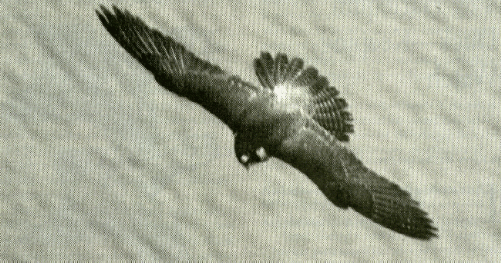
FALL 1995

A peregrine falcon defends nest with two chicks. Photo: Mark Elderkin
For the first time in 40 years, peregrine falcons have been discovered in Nova Scotia. Biologists conducting a Department of Lands and Forestry helicopter survey of potential habitats recently spotted a nestling and its mothing on a cliff face near the Bay of Fundy. Two adults and three young were later observed flying nearby.
Peregines are large, grace birds that can reach speeds up to 250 km/hr, making them the fastest creatures on earth. They were once plentiful across Eastern Canada and Europe. Widespread use of DDT (dichloro-diphenyl-trichloroethant) and other pesticides decreased their population after World War II. In 1978, they were declared an endangered species in Canada.
This discovery is a major success for the federal/provincial Peregrins Falcon Reintroduction Program of the 1980s and early 1990s. The program was co-sponsored by Environment Canada's Canadian Wildlife Service and the World Wildlife Fund, and managed locally by the Department of Lands and Forestry. It involved bringing one-month-old chicks from a Canadian Wildlife Service breeding facility in Alberta, rearing them in artificial nests called "hack boxes" near traditional cliffside nesting areas, and then releasing them. Within weeks, through their natural instinct, the young birds were hunting.
The last nesting pair was spotted in 1955 at Cape d'Or. Of the 105 peregrines reintroduced in Nova Scotia, some have been spotted as for away as Cuba and England, but only a handful of single birds have returned from their migrations. With similar successes in New Brunswick, this new nest brings to six the number of known paris of nesting peregrines throughout the Maritime provinces.
The exact location of the nest will remain secret for the protection of the birds. However, the public is encouraged to keep an eye out for peregrine falcons in the province and to report any sightings to the Canadian Wildlife Service or the Department of Lands and Forestry. These large birds are easily recognized by their large feet, distinct hooked bill with "moustache" markings, a white barred chest, and slate blue feathers.